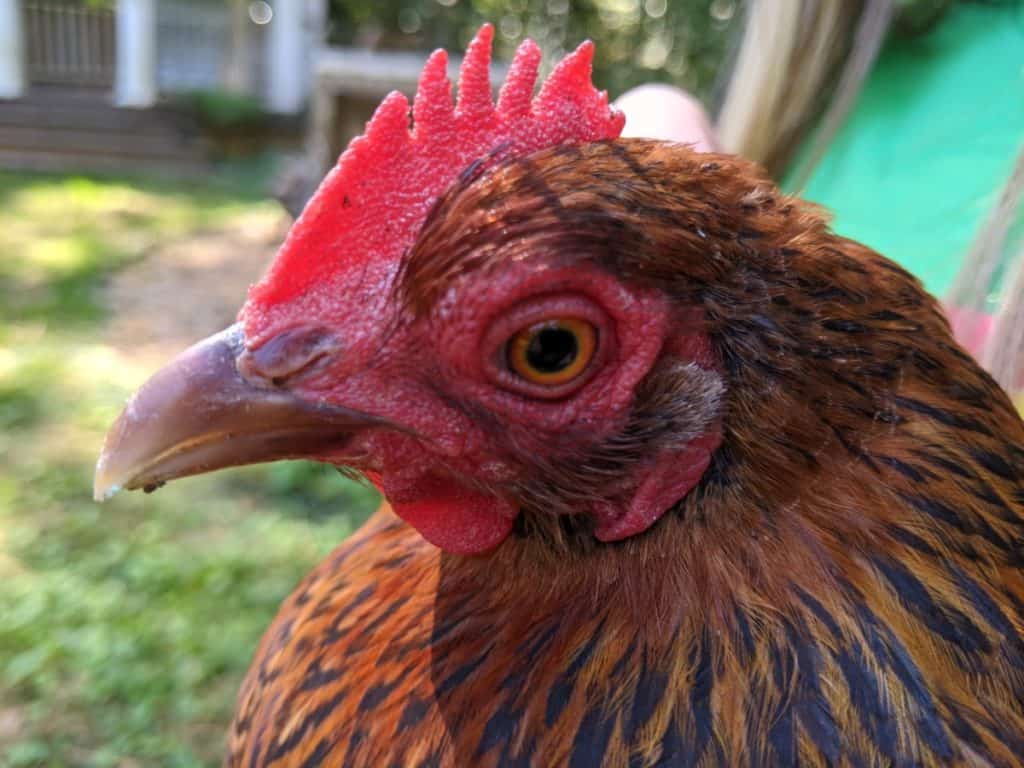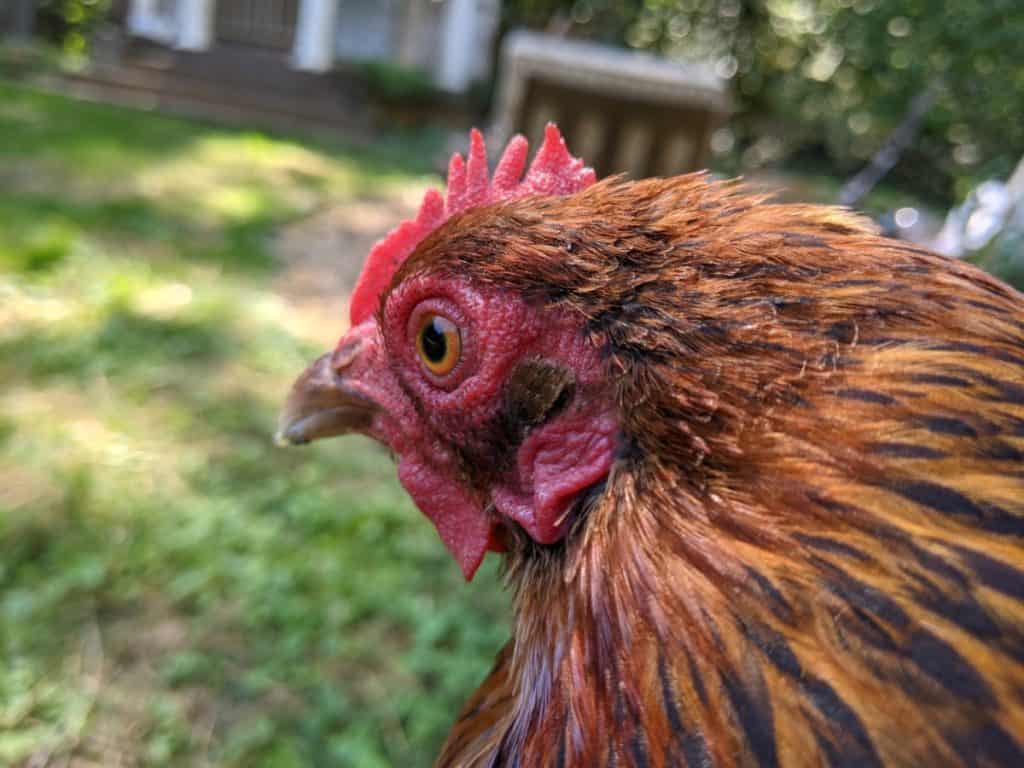Many people are shocked when they find out chickens have ears, and even more so when they discover chickens have earlobes too! As a backyard chicken keeper, understanding what their earlobes can indicate is useful. Here is everything you need to know about chickens’ earlobes.
The color of a chicken’s earlobes is a genetic trait. Chickens’ earlobes vary in color from red to white, blue, green, or even iridescent. Earlobe color can predict the shell color of the eggs a hen will lay with relative accuracy. Their earlobes also indicate signs of stress or illness.
One can tell a lot about a chicken by looking at its earlobes. Young hens’ earlobes will turn white before they lay their first eggs in spring.
The color of the earlobes and the presence of dry skin or scabs can indicate infections, being egg bound, or having a parasite. Regularly checking your flocks’ earlobes is a great way to monitor your chickens’ health.

Where Are Chickens’ Earlobes Located?
Some of you may only just be processing that chickens even have earlobes, so let us start with the basics – where are their ears and earlobes located, and how do they look?
Chickens do not have cartilaginous outer ears like humans. Rather they have an internal ear pit that is covered by fine feathers to protect it from parasites and dust.
Look at the sides of their heads, behind the eye and above the wattle – the earlobes look like a small, raised patch of skin, and the ear is just above this. Often people think the lobe is just another part of the wattle, especially if it is red.
What Determines Earlobe Color in Chickens?
Chickens have genes in their DNA that determine their earlobe color. Different breeds of chickens have different earlobe colors, but there can also be variations within a breed. In some breeds, earlobe color is a sex-linked trait.
Chickens’ earlobes are rich in blood vessels, and therefore the color of their earlobes can change as blood moves into or out of the tissue.
Chickens’ earlobes are thus an important indicator of their health. The earlobes can become paler, go completely white, or turn blue or purple.
What You Can Tell from A Chicken’s Earlobes
Chickens’ earlobes can indicate a range of diseases, illnesses, or parasites. Checking the color and texture or your flocks’ earlobes is an easy way to keep tabs on their health. Using the earlobes as a way to quickly recognize problems in your flock allows you to intervene early.
Here is a guide to what some changes in earlobe color and texture could indicate:
| Symptom | Possible cause |
| Dry, scabby skin on earlobes and wattle | Mites |
| Rough, flakey skin with off-white scabs | Ringworm |
| Pale earlobes, lethargic, waddling walk | Egg bound |
| Pale earlobes, reduced laying, and feeding | Stress |
| Blue or purple-colored earlobes | Possible heart condition |
Reasons Chickens’ Earlobes Turn White
Chickens with pure white earlobes have a pigment called purine in their skin. In certain breeds, the lobes usually turn white at around a year of age.
Some young chickens’ earlobes turn white in the weeks before they come into lay for the first time. Chicken farmers use the change in earlobe color as an indicator for when chickens will start laying eggs.
The earlobes are rich in blood vessels. When chickens are stressed or lack nutrients like iron in their diet, the wattle, comb, and earlobes will turn pale or even white, indicating anemia or stress.

Does a Chickens Earlobes Determine Egg Color?
Usually, chickens with white earlobes lay white eggs, and hens with red ones lay brown eggs. Hens with blue lobes may lay blue eggs, and hens with green or iridescent lobes can lay rare green eggs!
For example, Polish, Sultans, and White Leghorns have white lobes and lay white eggs. Sussex, New Hampshire Red, Australorp, Rhode Island Red, and Buff Orpington have red lobes and lay brown eggs. Some Easter Egger has green earlobes and lays green eggs, and some Araucana have blue lobes and lay blue eggs.
However, there are many exceptions – too many to assume that egg color is determined by earlobe color. For example, Silkies have blue earlobes yet lay white eggs. Some Araucanas, and Ameraucanas have red lobes and lay blue eggs. Therefore, there is no hard-and-fast rule about earlobe and egg color.
What Determines a Hen’s Egg Color?
The color of the eggs a chicken lays is genetically determined, so egg color is linked to breed. Mixed breed chickens may have different colored lobes and eggs, but heritage breeds generally have matching earlobe and egg colors.
When an egg is produced inside a chicken’s body, it starts off white, because eggshells are made of calcium carbonate, which is white. If a chicken has genes that cause the pigment, oocyanin, to be present around the egg, the egg will remain white as it moves through the oviduct.
However, if a chicken has the gene that causes porphyrins to be present around the egg as it moves through the oviduct, the egg will turn brown, blue, or green.

What chickens have white earlobes?
- Altsteirer
- Ancona
- Andalusian
- Barbezieux
- Bantam Deathlayer
- Campin
- Catalana
- Dampierre
- Dutch Bantam
- Empordanesa
- Frisian Gull
- Hamburg
- Lakenvelder
- Leghorn
- Legbar
- La Flèche
- Lyonnaise
- Merlerault
- Minorca
- Orust
- Ostfriesische Möwe
- Pyncheon
- Phoenix
- Penedesenca
- Rosecomb Bantam
- Queen Silvia
- Sulmtaler
- Smaaland
- Vorwerk
Conclusion
Chickens’ earlobes are small patches of skin behind the eye, just above the wattle. Different breeds of chicken have different colored earlobes, and within a breed, there can also be variation in earlobe color. Most commonly, they are red or white, but some breeds, like Silkies and Easter Eggers, have blue or green earlobes.
The color of egg a chicken lays is related to the color of its earlobes, but the two traits are not directly linked with genes. There is a myth that chicken earlobes’ color determines their egg color, but this is not true. A lot of the time, chickens with white lobes lay white eggs, and hens with red lobes lay brown eggs, but this is not always the case!
Chickens’ earlobes can be used as an indicator of their health. Regularly checking for changes in the color and texture of your flocks’ earlobes, wattles, and combs allow you to quickly notice signs of illness, pests, or stress.

